
Kastellet (Danish: The Castle), a house in Roskilde, Denmark, is the former home of the Danish author and satirist Gustav Wied.

Kastellet (Danish: The Castle), a house in Roskilde, Denmark, is the former home of the Danish author and satirist Gustav Wied.
The house was built to Wied's own design in 1900 with the proceeds from Første Violin, a comedy published in 1898. After a visit, his friend and colleague Walter Christmas referred to the house as "Kastellet" due to its castle-like architecture, and Wied instantly adopted the name, always using it in reference to his home thereafter.
The property also includes a small half-timbered building known as the Widow Seat and an outbuilding known as the Gentlemen's Wing, connecting to a garden wall.
Both the buildings, the garden and a memorial grove with 28 memorials were listed by the Danish Heritage Agency in 1996. [1]

Virum is a mostly residential, suburban neighbourhood in Lyngby-Taarbæk Municipality, located on both sides of Lyngby Kongevej, approximately 15 km north of central Copenhagen, Denmark. The neighbourhood is bounded by Lake Furesø to the west, Holte in Rudersdal Municipality to the north, Brede to the east and Kongens Lyngby and Sorgenfri to the south. Virum station is located on the Hillerød radial of the S-train network and is served by the Btrains. Virum is known for its religious society.

Kastellet located in Copenhagen, Denmark, is one of the best preserved fortresses in Northern Europe. It is constructed in the form of a pentagon with bastions at its corners. Kastellet was continuous with the ring of bastioned ramparts which used to encircle Copenhagen but of which only the ramparts of Christianshavn remain today.

Indre By, also known as Copenhagen Center or K or Downtown Copenhagen, is an administrative district (by) in central Copenhagen, the capital of Denmark. It covers an area of 4.65 square kilometres (1.80 sq mi), has a population of 26,223, and a population density of 5,638 per km².

St. Catherine's Priory, Roskilde was a Danish priory of Dominican friars located in Roskilde. It was established in 1231 and dissolved during the Reformation. In 1699, the private house which replaced the Priory, became the Lutheran Roskilde Adelige Jomfrukloster, a women's collegiate foundation.
Æbelholt Abbey was an Augustinian monastery situated at Tjæreby in Hillerød municipality in North Zealand, Denmark.

Sorgenfri Palace is a royal residence of the Danish monarch, located in Lyngby-Taarbæk Municipality, on the east side of Lyngby Kongevej, in the northern suburbs of Copenhagen. The surrounding neighbourhood is called Sorgenfri after it. Only the cellar and foundations survive of the first Sorgenfri House, which was built in 1705 to design by François Dieussart. The current house was built in 1756 by Lauritz de Thurah and later adapted and extended by Peter Meyn in the 1790s. Lauritz de Thurah has also designed buildings which flank the driveway closer to the road.

Gustav Johannes Wied was a Danish writer.

Langelinie is a pier, promenade and park in central Copenhagen, Denmark, and home of The Little Mermaid statue. The area has for centuries been a popular destination for excursions and strolls in Copenhagen. Most cruise ships arriving in Copenhagen also berth at Langelinie Pier.

Glorup is a manor house located between Nyborg and Svendborg in the south-east of the Danish island Funen. Rebuilt to the design of Nicolas-Henri Jardin and his pupil Christian Josef Zuber in 1763–65, it is considered one of the finest Baroque complexes in Denmark and was included in the 2006 Danish Culture Canon.

Bakkehuset is a historic house museum on Rahbeks Allé in the Frederiksberg district of Copenhagen, Denmark. Dating from the 1520s, it has served a number of functions over the years, including as a farmhouse, inn, private home, psychiatric hospital and orphanage. It is particularly associated with the Danish Golden Age when it was owned by Knud Lyne Rahbek and his wife, Kamma Rahbek, used it as a venue for her salons.

Absalon's Castle, was a fortification on the island of Slotsholmen in Copenhagen, located at the site of the later Copenhagen Castle and Christiansborg Palace. According to the chronicler Saxo Grammaticus, the castle was founded by Bishop Absalon in 1167 to protect the emerging city of Copenhagen. The castle survived for 200 years before it was destroyed in 1369 by the Hanseatic League, who first occupied and plundered it, and then demolished it completely.

Esplanaden is a street in Copenhagen, Denmark. It extends eastwards from Store Kongensgade and runs along the south side of the city's 17th-century fortress Kastellet and Churchillparken until it reaches the waterfront at Nordre Toldbod, just south of Langelinie, passing Amaliegade, Bredgade and Grønningen on the way. It marks the northern border of the Frederiksstaden district.

Grønningen is a street in central Copenhagen, Denmark, connecting Bredgade and the intersecting street Esplanaden to Oslo Plads in front of Østerport Station along the southwestern margin of the fortification Kastellet. It lends its name to the artists' cooperative Grønningen which was originally based in the street.
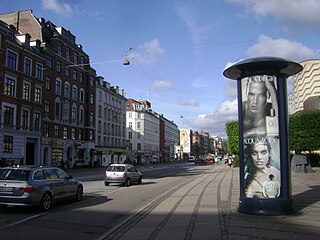
Gammel Kongevej is the principal shopping street of Frederiksberg in Copenhagen, Denmark. Running roughly parallel to Frederiksberg Allé and Vesterbrogade, it extends from Vesterport station at the southern end of The Lakes and continues for some 1.8 km west to Frederiksberg City Hall Square where it continues as Smallegade. In the opposite end, Jernbanegade connects it to Copenhagen City Hall Square.
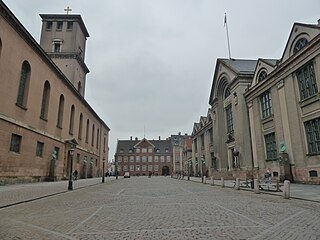
Frue Plads is a public square located on the north side of the Church of Our Lady in central Copenhagen, Denmark. It occupies a rectangular space which is bounded on the other sides by University of Copenhagen's main building to the north, Nørregade to the west and pedestrianized Fiolstræde to the east.
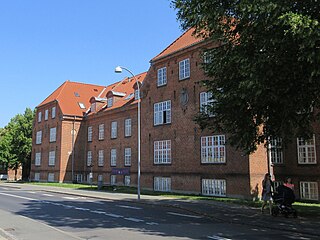
Roskilde Barracks, now known as Kildegården, is a former military barracks on Helligkorsvej in Roskilde, Denmark. The buildings are now owned by Roskilde Municipality and used as a hub for local sports clubs and other public associations and societies.
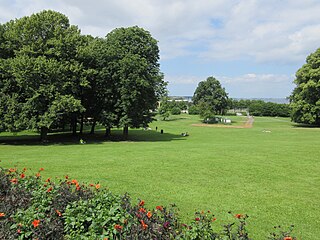
Byparken is a public park in central Roskilde, Denmark. It was founded in 1915 and was partly financed through a donation of the textile manufacturer O. H. Schmeltz. The park adjoins Provstevænget, a small protected field next to Roskilde Cathedral. Together, the two areas form a large green space between the cathedral and Roskilde Fjord.

Haraldsborg is a historic property located close to Roskilde Fjord in northeastern Roskilde, Denmark. As of 2017, it is being converted into a Christmas seal home for socially challenged children.
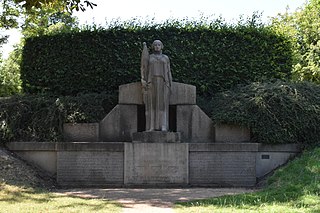
The Memorial to Nordic Volunteers and Fallen, located on Smedelinien, part of Kastellet, is a memorial to 28 Norwegian, Swedish and Finnish volunteers of the First (1848-50) and First Schleswig War (1864). It was inaugurated in 1920 to design by Anders Bundgaard.
The L. A. Ring HouseL. A. Rings Villa, located at Havnevej 25, is the former home of painter L. A. Ring and his wife Sigrid Ring, née Kähler in the Sankt Jørgensbjerg district of Roskilde, Denmark. The house is located on a sloping site overlooking St. Jørgensbjerg Village, Roskilde Harbour, and Roskilde Cathedral. It was listed on the Danish registry of protected buildings and places in 2001.